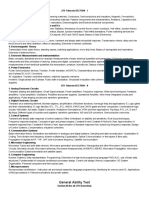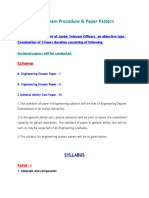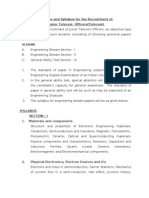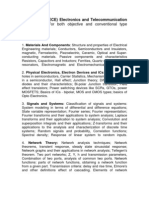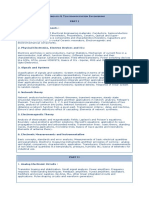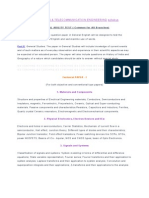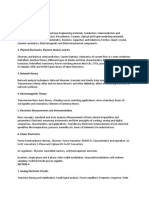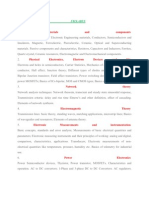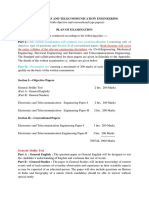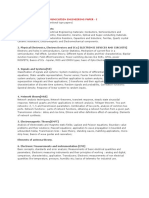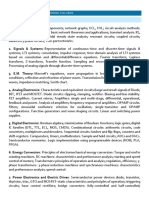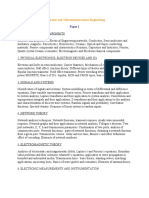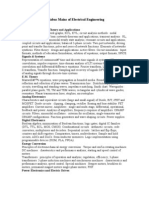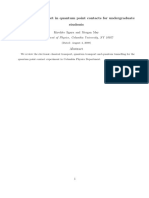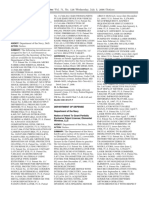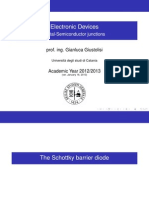BSNL
BSNL
Uploaded by
Pankaj Kumar BhartiCopyright:
Available Formats
BSNL
BSNL
Uploaded by
Pankaj Kumar BhartiCopyright
Available Formats
Share this document
Did you find this document useful?
Is this content inappropriate?
Copyright:
Available Formats
BSNL
BSNL
Uploaded by
Pankaj Kumar BhartiCopyright:
Available Formats
BSNL-JTO 2008 EXAM Syllabus
Last Updated on Tuesday, 8 July 2008 05:33 Written by Editor Sunday, 2 March 2008 07:42
Negative marking is 33%. Generally cut off for general category students i s around 50 marks out of 150, which will be less forO.B.C/S.C/S.T category students. There will be no interview for final selection, cri terion will be only wri tten examination. -60 The objective type examination shall be of 3 hours duration wi th one question paper containing 3 sections of Engineering Stre Section-I, Engineering Stream Section-II and General Ability Test Section The Engineering Stream Section-I and Section-II would include 50 questions each am -III. and General Ability test Section-III would include 20 questions. However, there would be no separatetime fi xed for attempting the separate sections.
SECTION I
1. Materials and components Structure and properties of Electronic Engineering material s, Conductors, Semi conductors and Insulators, Magneti c, Ferroelect Piezoelectric, Cerami c, Optical and ric, Superconducting material s. Passi ve components and characteristics, Resi stors, Capaci tors and Inductors; Ferrites, Quartz crystal , Cerami c resonators, Electromagnetic and Electromechanical components. 2. Physical Electronics, Electron Devi ces and ICs Electrons and holes in semiconductors, Carrier Stati sti cs, Mechanics of current flow in a semi -conductor, Hall effect; Junction theory; Different types of diodes and their characteristics; Bipolar Junction transi stor;eld effect transistors; Power swi tch devices like SCRs, CTOs, power Fi ing MOSFETs; Basics of ICs-bipolar, MOS and CMOS types; Basi cs of Opto Electronics. 3. Network theory Network anal ysi s techniques: Network theorem, transient and steady state sinusoidal response, and Transmission criteri a: lay and ri se time Elmores and other definition, effect of cascading. Elements of network synthesis. de 4. El ectromagneti c Theory Transmission lines: basic theory, standing waves, matching applications, micro strip lines; Basi cs of waveguides and resonato El ements of antenna theory. rs; 5. El ectronic Measurements and instrumentation Basic concepts, standards and error anal ysi s; Measurements of basic electri cal quantities and parameters; Electronic measurin g instruments and their principles of working: analog and digital, comparison, characteristics, andapplications. Transducers; El ectronic measurements of nonelectri cal quantities li ke temperatur pressure, humidity etc. Basics of telemetry for industrial use. e, 6. Power El ectronics Power Semiconductor devices, Thyristor, Power transistor, MOSFETs, Characteristics and operation. AC to DC converters; -Phase and 3-phase DC-to-DC Converters. 1 AC regul ators. Thyristor controlled reactors, switched capaci tor networks. Inverters: Single-phase and 3-phase. Pulse width modulation. Sinusoidal modulation with uniform sampling. Switched mode power supplies.
SECTION-II
1. Analog Electronic Circuits Transistor biasing and stabilization, Small Signal analysis. Power amplifiers. Frequency response, Wide band techniques, Feedack amplifiers. Tuned amplifiers. Oscillators. Rectifi ers and power supplies. Operational Amplifier, other linear integrated circuits and applicati Pulse b ons. shaping circuits and waveform generators. 2. Digital Electronic Circuits Transistor as a swi tching element; Boolean alge bra, simplification of Boolean functions, Karnaugh Map and applications; IC Logic gates and their characteri sti cs; IC logicamilies: DTL, TTL, ECL, NMOS, PMOS and CMOS gates and their comparison; Combinational logic circuits; Half f nd adder, full adder; Digital Compartor; Multiplexer Demultiplexer; ROM and their applications. Flip-flops, R-S, J-K, D and T flip-flops; Di fferent types of counters a registers; waveform generators. A/D and D/A convertors. Semiconductor memories. 3. Control Systems Transient and steady state response of control systems; Effect of feedback on stability and sensi tivity, Root locus techniqueFrequency response analysi s. Concepts of gain and phase margins; ConstantM and Constant-N Nichols Chart; Approximation of transient response from s; Constant-N Ni chols Chart; Approximation of transient response from closed loop frequency response; Design of Control Systems, Compensators; Industrial controllers. 4. Communication systems Basic information theory: Modulation and detection in analogue and digital systems; Sampling and data reconstruction. Quantiz ation & Coding; Time divi sion and frequency division multiplexing; Equalisation; Optical Communication: in free space & fiber optic; Propagation of signals at HF, VHF, UHF and microwave frequency; Satellite communication. 5. Microwave Engineering Microwave Tubes and solid state devices, Microwave generation and amplifiers, Waveguides and other Microwave Components and Circuits, Microst circuits, Microwave antennas, Microwave Measurements, MASERS LASERS; Microwave Propogation. Microwave rip Communication Systems-terrestrial and satellite based. 6. Computer Engineering Number Systems; Data representation; Programming; Elements of a high level programminglanguage PASCAL/C; use of basic data structures; Fundamental s of computer architecture processor design; Control unit design; Memory organization. I /O System Organization. Personal computers and their typical uses. 7. Microprocessors Microprocessor architecture Instruction set and simple assembly language programming. Interfacing for memory and I/O. Applications of Microprocessors in Telecommunications and power system
You might also like
- Maytag Maxima Washer MHW6000XW Service PDFDocument52 pagesMaytag Maxima Washer MHW6000XW Service PDFCarlos RuizNo ratings yet
- JTO SyllabusDocument2 pagesJTO SyllabusJiya SinghNo ratings yet
- BSNL Exam Procedure & Paper Pattern: SchemeDocument5 pagesBSNL Exam Procedure & Paper Pattern: SchemesubathirangNo ratings yet
- Paper - I: General Ability TestDocument4 pagesPaper - I: General Ability TestMerril VincentNo ratings yet
- Scheme and Syllabus For The Recruitment of Junior Telecom Officers (Telecom)Document8 pagesScheme and Syllabus For The Recruitment of Junior Telecom Officers (Telecom)akshay4849No ratings yet
- Junior Telecom Officer (JTO)Document1 pageJunior Telecom Officer (JTO)Siva Kumar AvisNo ratings yet
- IES Syllabus: 1. Materials and ComponentsDocument2 pagesIES Syllabus: 1. Materials and ComponentsKishlay KrNo ratings yet
- Ies: Electronics & Telecommunication Engineering Paper - I: 1. Materials and ComponentsDocument5 pagesIes: Electronics & Telecommunication Engineering Paper - I: 1. Materials and ComponentsrkbazadNo ratings yet
- IES SyllabusDocument5 pagesIES SyllabusGopi ShrineNo ratings yet
- Materials and ComponentsDocument3 pagesMaterials and ComponentsabhiranyuNo ratings yet
- PSU SyllabusDocument3 pagesPSU Syllabusrahaman.besu5321No ratings yet
- Materials and Components:: E & T E IDocument2 pagesMaterials and Components:: E & T E IAnonymous p0bBEKNo ratings yet
- For Both Objective and Conventional Type PapersDocument2 pagesFor Both Objective and Conventional Type PapersiisclaxmanNo ratings yet
- Ies Indian Engineering Services Electronics Ece Syllabus General Ability TestDocument3 pagesIes Indian Engineering Services Electronics Ece Syllabus General Ability TestpalleshankerNo ratings yet
- SyllabsDocument2 pagesSyllabsRohit SharmaNo ratings yet
- Electronics & Telecommunication Engineering Syllabus: GENERAL ABILITY TEST (Common For All Branches)Document3 pagesElectronics & Telecommunication Engineering Syllabus: GENERAL ABILITY TEST (Common For All Branches)pawantwrNo ratings yet
- Ies Ec SyllabusDocument2 pagesIes Ec SyllabusPriyaSinghNo ratings yet
- UPSC ESE Electronics & Telecommunication Engineering Syllabus Paper I SyllabusDocument3 pagesUPSC ESE Electronics & Telecommunication Engineering Syllabus Paper I SyllabusnfgbngfbhgdNo ratings yet
- Syll Lec Elecroeng 29 09 2014Document2 pagesSyll Lec Elecroeng 29 09 2014Dharmendra MehtaNo ratings yet
- Es Electronics SyllbDocument3 pagesEs Electronics Syllbabhikr77No ratings yet
- Materials and ComponentsDocument3 pagesMaterials and ComponentssarathNo ratings yet
- (For Both Objective and Conventional Type Papers) : Electronics and Telecommunication Engineering Paper-IDocument5 pages(For Both Objective and Conventional Type Papers) : Electronics and Telecommunication Engineering Paper-IgeombajobsNo ratings yet
- Part A:: GENERAL ABILITY TEST (Common For All Branches)Document4 pagesPart A:: GENERAL ABILITY TEST (Common For All Branches)Ajay VishwakarmaNo ratings yet
- (For Both Objective and Conventional Type Papers) 1. Materials and ComponentsDocument5 pages(For Both Objective and Conventional Type Papers) 1. Materials and Componentsmohit4821No ratings yet
- IES E&TC SyllabusDocument3 pagesIES E&TC Syllabusvipin12krishnanNo ratings yet
- RaoufDocument2 pagesRaoufRaouf ValayappuramNo ratings yet
- BSNL Jto SyllabusDocument3 pagesBSNL Jto Syllabuslakshmi2348No ratings yet
- CCCCCCCCCDocument3 pagesCCCCCCCCCKumar AbhinavNo ratings yet
- Electronics & Telecommunication Engineering SyllabusDocument3 pagesElectronics & Telecommunication Engineering SyllabusArizulIslamNo ratings yet
- What Are The Subjects Which Come in UPSC Engineering Services - Electronics - Communication - ExamDocument2 pagesWhat Are The Subjects Which Come in UPSC Engineering Services - Electronics - Communication - ExamVikas ChandraNo ratings yet
- Materials and Components:: Ies Syllabus EceDocument2 pagesMaterials and Components:: Ies Syllabus EceRipan DeuriNo ratings yet
- IES - Syllabus PDFDocument3 pagesIES - Syllabus PDFGulzar AhamdNo ratings yet
- BSNL Jto SyllabusDocument4 pagesBSNL Jto SyllabusRatnesh MishraNo ratings yet
- JtoDocument2 pagesJtosunny112811No ratings yet
- Electrical Engineering Syllabus For UPSC Main ExaminationDocument3 pagesElectrical Engineering Syllabus For UPSC Main ExaminationsujaraghupsNo ratings yet
- Electronics & Telecommunication Engineering Paper - IDocument3 pagesElectronics & Telecommunication Engineering Paper - ISaurabh WadhwaNo ratings yet
- Electronics & Telecommunication Engineering - Ies (Paper - I)Document4 pagesElectronics & Telecommunication Engineering - Ies (Paper - I)Archana TripathiNo ratings yet
- TelecomDocument2 pagesTelecomDinesh PatelNo ratings yet
- Paper - I 1. Circuit Theory:: Electrical EngineeringDocument3 pagesPaper - I 1. Circuit Theory:: Electrical EngineeringEr Paramjit SinghNo ratings yet
- UPSC CSE Electrical Engineering SyllabusDocument2 pagesUPSC CSE Electrical Engineering Syllabusbpsharmab1p1No ratings yet
- Syllabus of Assistant Radio Officer Examination (Objective Type) Electronics & CommunicationDocument10 pagesSyllabus of Assistant Radio Officer Examination (Objective Type) Electronics & CommunicationEr Prithvi Raj SinghNo ratings yet
- Target-GATE: Tell Your FriendsDocument4 pagesTarget-GATE: Tell Your FriendsAth SydNo ratings yet
- B.Tech. (IEE) Syllabus (New) : First Year First SemesterDocument26 pagesB.Tech. (IEE) Syllabus (New) : First Year First SemesterAnasua SarkarNo ratings yet
- Electrical Engineering Syllabus For IESDocument3 pagesElectrical Engineering Syllabus For IESSanjay YadavNo ratings yet
- UPSC Syllabus Electrical EngineeringDocument3 pagesUPSC Syllabus Electrical EngineeringMOHD ALI SHAMSINo ratings yet
- Upsc CSE Ele SyllabusDocument2 pagesUpsc CSE Ele SyllabusgppNo ratings yet
- Electrical SyllabusDocument2 pagesElectrical SyllabusSumit SinghNo ratings yet
- Eletrical SyllabusDocument3 pagesEletrical SyllabusRadhey LoyaNo ratings yet
- SylubusDocument7 pagesSylubusnitnannuNo ratings yet
- Electrical Main Syll IasDocument3 pagesElectrical Main Syll IasRNikaNo ratings yet
- Electronic and Telecommunications EngineeringDocument3 pagesElectronic and Telecommunications EngineeringmailforpriyanshuNo ratings yet
- Syllabus Mains of Electrical EngineeringDocument3 pagesSyllabus Mains of Electrical Engineeringapi-3710029No ratings yet
- Syllabus For IES in Electronics&Communication PaperDocument4 pagesSyllabus For IES in Electronics&Communication PaperRitesh Kumar BhadaniNo ratings yet
- IES Syllabus For ETCDocument5 pagesIES Syllabus For ETCAnand ShankarNo ratings yet
- Syllabus Electrical Engg CseDocument7 pagesSyllabus Electrical Engg CseKrishna Mohan ChauhanNo ratings yet
- Syllabus For BSNL JTODocument10 pagesSyllabus For BSNL JTOSriramamurthy GurugubelliNo ratings yet
- Stage I - Paper I, Objective Type, Common To All Candidates, 2 Hours Duration, 200 Marks MaximumDocument3 pagesStage I - Paper I, Objective Type, Common To All Candidates, 2 Hours Duration, 200 Marks MaximumAayushGoyalNo ratings yet
- General AbilityDocument3 pagesGeneral Abilitysanketdesai1988No ratings yet
- Paper IDocument3 pagesPaper IER Raman Kumar ChaurasiaNo ratings yet
- Signal Integrity: From High-Speed to Radiofrequency ApplicationsFrom EverandSignal Integrity: From High-Speed to Radiofrequency ApplicationsNo ratings yet
- Arduino Measurements in Science: Advanced Techniques and Data ProjectsFrom EverandArduino Measurements in Science: Advanced Techniques and Data ProjectsNo ratings yet
- Firetrol SBP1300-51Document17 pagesFiretrol SBP1300-51Dimas TorrealbaNo ratings yet
- Rachmat HidayatDocument2 pagesRachmat HidayatRachmat HidayatNo ratings yet
- Lectura Electronic Transport in Quantum Point Contacts For Undergraduate StudentsDocument6 pagesLectura Electronic Transport in Quantum Point Contacts For Undergraduate StudentsMateo EcheverriNo ratings yet
- 7017 IntegratedPower PS 20210903 WebDocument12 pages7017 IntegratedPower PS 20210903 Webbaskaranjay5502No ratings yet
- Yearly Plan Form 1 IctlDocument9 pagesYearly Plan Form 1 IctlrokhmahisahakNo ratings yet
- 7805 Voltage Regulator CircuitDocument2 pages7805 Voltage Regulator CircuitArmoured SmilerNo ratings yet
- Quest NetVault Backup 863 Installation Guide EnglishDocument96 pagesQuest NetVault Backup 863 Installation Guide EnglishOliver OrtizNo ratings yet
- DTSU666 Three Phase Electronic Energy Meter User Manual: 1.overview of ProductsDocument2 pagesDTSU666 Three Phase Electronic Energy Meter User Manual: 1.overview of ProductsPhúc Lê ĐứcNo ratings yet
- Wireless Modem: Wifi DSLDocument12 pagesWireless Modem: Wifi DSLAnand BhatNo ratings yet
- B-84175EN/03 Troubleshooting: Figure 3.7.1-1 LED On The Main BoardDocument6 pagesB-84175EN/03 Troubleshooting: Figure 3.7.1-1 LED On The Main Boardkaori quinteroNo ratings yet
- DatasheetDocument2 pagesDatasheetGibson MichaelNo ratings yet
- Untitled DocumentDocument1 pageUntitled DocumentMuhammad Faiz SarwarNo ratings yet
- Module Sorting Machine AnalysisDocument4 pagesModule Sorting Machine AnalysisHalem Hafidz KadirNo ratings yet
- HX Stomp Cheat SheetDocument2 pagesHX Stomp Cheat SheetGeorge ChristiansenNo ratings yet
- 20-PS Iec 62040-2-2018 - FinalDocument39 pages20-PS Iec 62040-2-2018 - FinalMaLik AtifNo ratings yet
- Modul 02 Siskom2 Matched FilterDocument17 pagesModul 02 Siskom2 Matched FilterAmir MiftahudinNo ratings yet
- Denon mc3000 Manual PDFDocument41 pagesDenon mc3000 Manual PDFMrDarcy de BennetNo ratings yet
- 19ci Plan Your Visit1Document8 pages19ci Plan Your Visit1Partha BarmanNo ratings yet
- Acuson S SeriesDocument11 pagesAcuson S Seriesfernandovela91No ratings yet
- Emulation of Wind Turbine Using DC Motor: Lipsa Priyadarsini (110ee0219) & CHANDRANI DAS (110EE0236)Document49 pagesEmulation of Wind Turbine Using DC Motor: Lipsa Priyadarsini (110ee0219) & CHANDRANI DAS (110EE0236)Akshay PabbathiNo ratings yet
- VSX-1123-K Manual ENpdf PDFDocument115 pagesVSX-1123-K Manual ENpdf PDFJack SawyerNo ratings yet
- USB-A To Serial Cable: What's IncludedDocument1 pageUSB-A To Serial Cable: What's Includedabarboza4574No ratings yet
- Wired and Wireless Local Area NetworkDocument35 pagesWired and Wireless Local Area NetworkDeniary0% (1)
- Chemisry Investigatory ProjectDocument13 pagesChemisry Investigatory Projectmeghana soni100% (2)
- Notice: Patent Licenses Non-Exclusive, Exclusive, or Partially Exclusive: Elemental Wireless, LLCDocument2 pagesNotice: Patent Licenses Non-Exclusive, Exclusive, or Partially Exclusive: Elemental Wireless, LLCJustia.comNo ratings yet
- Compal Confidential: Schematics Document PAW20Document42 pagesCompal Confidential: Schematics Document PAW20Carlos Alberto Miranda PerezNo ratings yet
- Blackmagic Cameras ManualDocument609 pagesBlackmagic Cameras ManualMaciej SchwarzNo ratings yet
- 10 Metal-Semiconductor JunctionsDocument56 pages10 Metal-Semiconductor JunctionsKamalesh DebnathNo ratings yet

